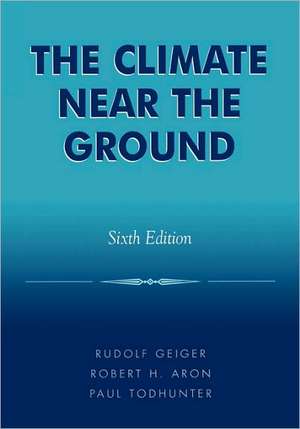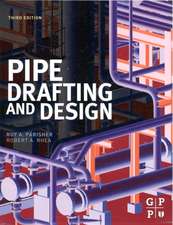The Climate Near the Ground
Autor Rudolf Geiger, Robert H. Aron, Paul Todhunteren Limba Engleză Hardback – 31 mar 2003
| Toate formatele și edițiile | Preț | Express |
|---|---|---|
| Paperback (1) | 407.01 lei 43-57 zile | |
| Vieweg+Teubner Verlag – 12 feb 2012 | 407.01 lei 43-57 zile | |
| Hardback (1) | 642.46 lei 38-44 zile | |
| Rowman & Littlefield Publishers, Inc. – 31 mar 2003 | 642.46 lei 38-44 zile |
Preț: 642.46 lei
Preț vechi: 793.16 lei
-19% Nou
Puncte Express: 964
Preț estimativ în valută:
122.93€ • 128.70$ • 101.72£
122.93€ • 128.70$ • 101.72£
Carte tipărită la comandă
Livrare economică 02-08 aprilie
Preluare comenzi: 021 569.72.76
Specificații
ISBN-13: 9780742518575
ISBN-10: 0742518574
Pagini: 600
Dimensiuni: 184 x 263 x 34 mm
Greutate: 1.23 kg
Ediția:6. Auflage.
Editura: Rowman & Littlefield Publishers, Inc.
ISBN-10: 0742518574
Pagini: 600
Dimensiuni: 184 x 263 x 34 mm
Greutate: 1.23 kg
Ediția:6. Auflage.
Editura: Rowman & Littlefield Publishers, Inc.
Recenzii
Aron and Todhunter truly have paid a great tribute to the revered microclimatologist Rudolf Geiger by this revision. As they state in the preface, their goal for this edition continues that of the previous editions, i.e., to present 'a clear and vivid textbook for those who are just taking up the study of microclimatology and, at the same time, to serve as a reference work for those already familiar with the subject.' In my opinion, they have succeeded. -- Katharine B. Perry, HortScience The authors have done a wonderful job of maintaining Geiger's tradition of excellence. I believe [the 5th edition] can help a new generation of students and scientists understand the mysteries and wonders of their surroundings. -- John W. Enz, Bulletin of the American Meteorological Society This is an updated edition of a well-known work that provides a clear description of the surface microclimate, its physical basis, and its interactions with the biosphere. This edition has been revised to keep abreast of current research in microclimatology, to provide more examples of work from North America, and to more clearly illustrate how surface energy fluxes are linked to the nature of the surface environment. American Meteorological Society Relatively few scientific books have useful lifetimes of over three-quarters of a century. Geiger provided a robust framework for empirical, physically based microclimatology that has stood the test of time. We should be grateful to professors Aron and Todhunter for keeping the text alive and current. International Journal Of Climatology This book retains vigorous reasoning and inspiring interpretations on a very wide range of subjects pertaining to the microclimate near the ground. Both the breadth and the depth of the microclimate processes discussed in this book make it a unique resource for those who desire a thorough introduction to the characteristics and causes of the surface microclimate, and a valued reference for both undergraduate and graduate meteorology and climate researchers. Bulletin of the American Meteorological Society Aron and Todhunter have updated Geiger's classic, incorporating numerous observations of climatic elements at the earth's land and sea surfaces and at short distances both above and below that interface. This work is nearly an encyclopedia, but it gives practical answers for general readers. Recommended. CHOICE
Cuprins
1. Microclimate and Research.- I. Earth’s Surface Energy Balance.- 2. Physical Basis of the Earth’s Radiation Balance.- 3. Components of the Energy Balance and Their Importance.- 4. Radiation Balance of the Earth’s Surface.- 5. Longwave Radiation at Night.- 6. The Laws of Energy Transport in the Ground.- 7. Transport of Energy in the Atmosphere. Eddy Diffusion.- 8. Mixing Due to Friction and Convection.- 9. Temperature Instability, Dissemination of Seeds, Dispersion of Air Pollutants, and Effective Stack Height as Problems of Eddy Diffusion.- II. The Air Layer over Level Ground without Vegetation.- 10. Normal Temperature Stratification in the Underlying Surface (the Ground).- 11. Temperature in the Lowest 100 m of the Atmosphere.- 12. The Unstable Sublayer and the Inversion Sublayer.- 13. Daytime Temperature of the Air Layer near the Ground.- 14. Nighttime Temperature of the Air Layer near the Ground.- 15. Distribution of Water Vapor above the Ground.- 16. The Wind Field and the Influence of Wind near the Ground.- 17. Distribution of Particulates and Trace Gases.- 18. Optical Phenomena Occurring near the Ground.- III. Influence of the Underlying Surface on the Adjacent Air Layer.- 19. Soil Type, Soil Mixtures, Soil Tillage.- 20. Ground Color, Surface Temperature, Ground Cover (Mulching) and Greenhouses.- 21. Soil Moisture and Ground Frost.- 22. The Air Layer above Small Water Surfaces.- 23. The Air Layer near the Water Surface of Lakes, Seas and Rivers.- 24. The Air Layer near Snow and Ice.- IV. Further Analysis of the Energy Balance.- 25. Basis and Methods of Evaluation.- 26. Results of Previous Energy Balance Measurements.- 27. Advective Influences and Transitional Climates.- 28. Remarks on Evaporation.- V. The Effect of Low Plant Cover on the Surface AirLayer.- 29. Energy Balance and Temperature of Plant Components.- 30. Radiation, Eddy Diffusion, and Evaporation in a Low Plant Cover.- 31. The Microclimate of Meadows and Grain Fields.- 32. The Microclimate of Gardens, Potato Fields, and Vineyards.- VI. Forest Climatology.- 33. Radiation in a Forest.- 34. Metabolism, Energy Storage and Wind in a Forest.- 35. Air Temperature and Humidity in a Forest.- 36. Dew, Rain, and Snow in a Forest.- 37. Microclimate at the Stand Edges.- 38. Further Problems Concerning the Local Climate of Forests.- 39. Climatic Influences of the Forest.- VII. The Influence of Topography on the Microclimate.- 40. Insolation on Various Slopes.- 41. The Effect of Differing Amounts of Sunshine on Microenvironment.- 42. Small-Scale Topographic Influences at Night (Cold Air Currents, Frost Hollows).- 43. Local Winds in Hilly and Mountainous Terrain.- 44. The Climate of Various Slopes (Exposure Climate).- 45. The Thermal Belt.- 46. Microclimate in the High Mountains.- 47. The Microclimate of Caves.- VIII. Interrelation of Animals and Humans to the Microclimate.- 48. Animal Behavior.- 49. Animal Dwellings.- 50. Bioclimatology.- 51. Urban Climate.- 52. Artificial Protection against Wind.- 53. Artificial Protection against Low Temperatures.- References.- Symbols.- Conversion Table.- Author Index.
Notă biografică
Die Bearbeiter: Prof. Aron lehrt Geographie und Klimatologie an der Universität Mount Pleasant, Michigan, USA; Dr. Todhunter ist Klimatologe an der Universität von Grand Forks, North Dakota, USA.












